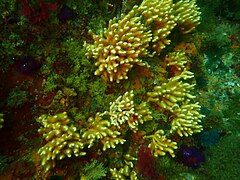The dive site Anvil Rock is an offshore rocky reef near Cape Point on the Cape Peninsula, near Cape Town in the Western Cape province of South Africa.
Understand
[edit]The site is just outside False Bay, southwest of Cape Point, in the Table Mountain Marine Protected Area. It is not dived often as it is a long ride, but it may be a good second dive on the way back after diving the Lusitania at Bellows Rock.
Position
[edit]1 Anvil Rock 3m pinnacle: S34°22.218' E18°31.090'. The nominal position and main pinnacle at the site.
This site is in the Table Mountain National Park Marine Protected Area (2004). A permit is required.
Name
[edit]The name "Anvil Rock" is marked on the nautical charts of the area as a known navigational hazard.
Depth
[edit]Maximum depth is deeper than 20 m. and the top of the pinnacle is about 3 m. (Average depth of a dive is likely to be about 18 m.)
Visibility
[edit]Not much is known about visibility at the site, but it is probably much like Bellows Rock.
Topography
[edit]Massive granite reef rising to a shallow pinnacle, with a smaller group of deeper pinnacles a short distance to the southwest.
Geology: Precambrian granite corestones of the Peninsula pluton.
Conditions
[edit]The site is exposed to wind and waves from all directions, so should be dived in calm winds and low swell. There may be strong surge and a slight current.
Get in
[edit]Access is by boat, usually from Simon's Town or the Millers Point slipway. The site is about (distance)km from Simon's Town jetty, or (distance)km from Miller's Point
Do
[edit]Dive at one of the drop points and explore the vicinity.
1 Anvil Rock 3m pinnacle: S34°22.218' E18°31.090'. The nominal position and main pinnacle at the site. This is a large, flat-topped shallow pinnacle rising to about 3 m, with a sheer wall on the south side dropping to more than 20 m. The west, north and east sides slope more gradually. There is a sand patch very near to the south east at 25 m, and a sand patch a bit further to the north at 31 m
2 Anvil Rock caves: S34°22.244' E18°31.068'. A deeper group of pinnacles about 13 m on top lies a bit further south, where the bottom is a bit deeper than 21 m. They are quite rugged and sheer sided, with some small caves and tight swim-throughs.
See
[edit]Marine life
[edit]The marine life is typical False Bay invertebrates, with large numbers of nippled sea fans, sponges and soft corals. The upper surfaces have quite heavy kelp growth, mostly split-fan kelp, and large red-bait pods in the shallower areas. There is a predominance of purples and blues over large parts of the reef, due to thriving purple soft coral and dentate moss animals.
- Nippled sea fans Eunicella papillosa are common on the southern pinnacles
- Sponges and soft corals
- Sponge on the reef at Anvil Rock
- Strawberry anemones Corynactis annulata and dentate moss animals Virididentula dentata
- Reef invertebrates at Anvil Rock
Photography
[edit]Macro photography is most likely toproduce good results, but wide angle may be good if the water is clean.
Suggested routes
[edit]At the south pinnacles, spend some time at about 20m, where there are a few small caves and swim-throughs.
Stay safe
[edit]Hazards
[edit]No special hazards are known, though the surge may be quite strong.
Skills
[edit]No special skills required, but much of the site is deeper than 18m, so it is more suited to advanced divers.
Equipment
[edit]A light for looking into the holes and swim-throughs, and a DSMB and reel, to let the boat know where you are surfacing. If there is a current, you could drift quite a long way during the ascent, and it is a long way to shore, even if the current does not sweep you out past Cape Point into the South Atlantic.
Nearby
[edit]Other offshore dive sites of False Bay:
- 1 Choirboys Reef
- 2 Seal Island
- 3 Drop Zone
- 4 East Shoal
- 5 Moddergat
- 6 Sterretjies Reef
- 7 York Shoal
- 8 SAS Fleur
- 9 Offshore Barges – North Barge
- 10 Steenbras Deep - South Pinnacles
- 11 Blue Flame Pinnacles
- 12 SATS General Botha
- 13 Off-Whittle Ridge
- 14 SAS Bloemfontein
- 15 Whittle Rock
- 16 Bruce's Mark
- 17 Deep South Whittle Reef
- 18 SS Lusitania
- 19 Rocky Bank
Back to the Alphabetical list of sites, or list of reef dive sites in the Southern False Bay offshore reefs area
Other regional dive sites:
- Dive sites of Table Bay and approaches,
- Dive sites of the Cape Peninsula west coast
- Dive sites of the Cape Peninsula east coast
- Dive sites of False Bay east coast
- Fresh water dive sites of the Cape Town Metropolitan Area









